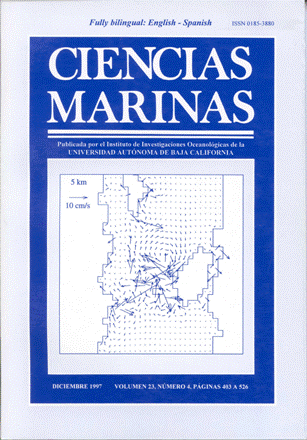Density and biomass of the meiofauna of the upper continental slope in two regions of the Gulf of Mexico
Main Article Content
Abstract
A comparative study of the density and biomass of the meiofauna distributed on the upper continental slope of the western and southern Gulf of Mexico was conducted on board the R/V Justo Sierra. A total of 48 samples were obtained with the aid of a Gomex box corer, at depths ranging from 196 to 540 m off the coast of Tamaulipas and Yucatán. Both regions have contrasting hydrographic and sedimentary conditions; the former is of terrigenous nature, while the latter is carbonaceous. The highest density and biomass values (mean = 1,829,216 ± 489,005 ind/m2 and 0.304 f 0.082 gC/m2, respectively) were recorded off Tamaulipas. These parameters were tive to six times lower in order of magnitude in the Yucatán slope. Meiofauna biomass values were significantly correlated with density (r2 = 0.99). Significant differences in density [Fc(1,46) = 38.51, P < 0.005] and biomass [Fc( 1,46) = 37.72, P < 0.005] were recognized between both areas studied. No clear spatial or bathymetric patterns were observed in the meiofaunal components identified in Tamaulipas. This pattern was attributed to the prevailing variable hydrographic conditions and the different organic carbon sources present in the westem region of the Gulf of Mexico. In contrast, the depth and particulate organic carbon of the Yucatán slope exert a significant influence on meiofaunal density and biomass. In this region, predation by larger size classes seems to control the density. The density and biomass values recorded in both regions of the gulf studied fall within the range of previous meiofauna reports from the northern Gulf of Mexico and similar slope habitats of the world oceans.
Downloads
Article Details
This is an open access article distributed under a Creative Commons Attribution 4.0 License, which allows you to share and adapt the work, as long as you give appropriate credit to the original author(s) and the source, provide a link to the Creative Commons license, and indicate if changes were made. Figures, tables and other elements in the article are included in the article’s CC BY 4.0 license, unless otherwise indicated. The journal title is protected by copyrights and not subject to this license. Full license deed can be viewed here.

